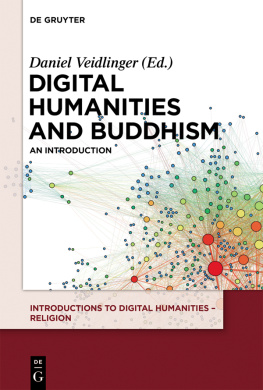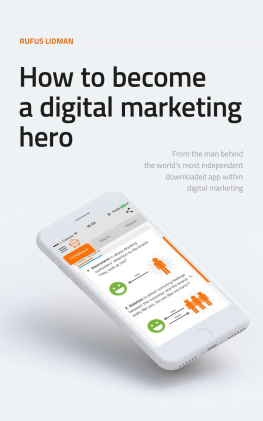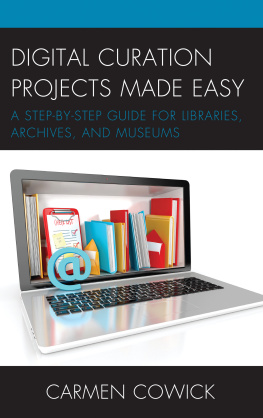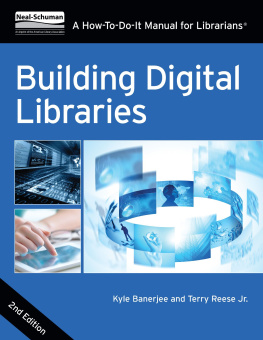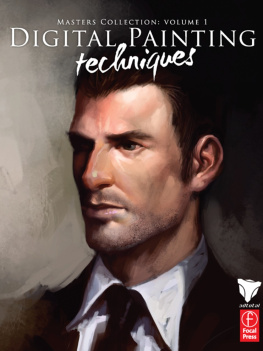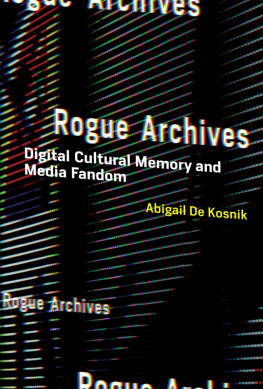Contents
Guide

Digital Humanities and Buddhism
Introductions to Digital Humanities Religion

Edited by
Claire Clivaz, Charles M. Ess, Gregory Price Grieve,
Kristian Petersen, Sally Promey
Volume 1
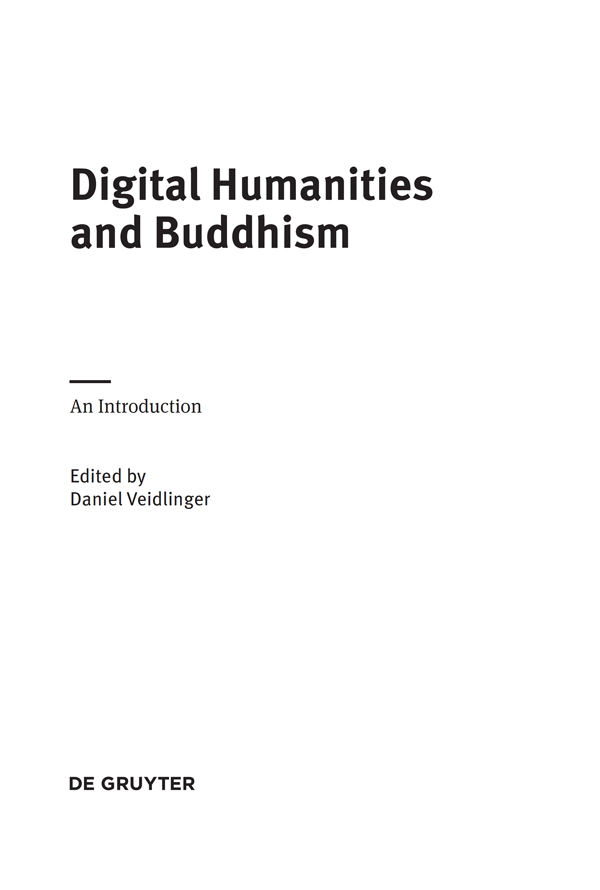
ISBN 978-3-11-051836-8
e-ISBN (PDF) 978-3-11-051908-2
e-ISBN (EPUB) 978-3-11-051839-9
Library of Congress Control Number: 2019933231
Bibliografic information published by the Deutsche Nationalbibliothek
The Deutsche Nationalbibliothek lists this publication in the Deutsche Nationalbibliografie; detailed bibliografic data are available on the Internet at http://dnb.dnb.de.
2019 Walter de Gruyter GmbH, Berlin/Boston
Cover image: Social network visualization. With friendly permission of Martin Grandjean.
http://www.degruyter.com
Daniel Veidlinger
Introduction
The Digital Humanities are a new way of approaching traditional Humanities disciplines using the analytic and display powers of computers and digital networks to gain novel and in many cases deeper insights into questions at the center of Humanities research. Some view Digital Humanities as a way to assist more traditional research projects, perhaps using more heavily data-driven methodologies, but others hail it as an entirely disruptive enterprise that seeks to fundamentally alter the way the Humanities are done ( and Ronald Musto announce in their primer for the Digital Humanities, The array of platforms, applications, techniques and tools, all developed under the rubric of digital, have been dramatically changing the way that humanists work, how they do research, gather information, organize, analyze and interpret it, and disseminate findings (Gardiner and Musto 2015, 3).
Just as the idea of the Humanities spans a vast and contested field, so there are many valences of the term Digital. At root, digital information is information that has been encoded and reduced into a binary series of ones and zeros that represent the original data and can be displayed once again through appropriate decoding. Because Digital Media reduce all text, images and sounds to numerical codes, they can consequently be described in mathematical terms, 2005, 194) and help us to cultivate better comprehension of the subject through further computational operations upon the model.
The various features of the digital open up vast new vistas for analysis, manipulation and transformation of the information so encoded. For example, whereas it is quite difficult to alter a photographic negative on film using hand-retouching or chemical agents, a digital image can be altered programmatically by changing the binary code that represents the image (, director of UCLAs Digital Humanities program reminds us, The benefits of being able to encode information, knowledge, artifacts, and other materials in digital format is always in tension with the liabilitiesthe loss of information from an analogue object, or, in the case of a born-digital artifact, its fragility to migration and upgrade (Drucker et al 2014, 9).
Another key feature of Digital Media that bears mentioning is that they enable random access to data just like human memory does. This is quite different from older forms of electric communication, such as cassette tapes or films, which have to be played through in a linear manner in order to find the information for which one is searching. Digital Media also can be connected into complex networks of exchange that communicate with each other through binary code and open up unprecedented opportunities for collaborative research. This networking feature allows digital archives, for example, to store an enormous amount of material that has been centralized from locations all over the world, obviating the need to travel to these archives in order to do research using their collections. Digital technologies are distinct for being highly scalable, meaning that they can be expanded relatively easily to perform larger and larger quantities of work as necessary, and for being modular, meaning that they can be separated as discrete units and combined in different ways in order to be customized for different tasks. All of these features of digital technologies will be covered in the various chapters of this volume, and their application specifically to Buddhist studies will be addressed.
There has been a fair degree of debate about the usefulness, desirability and effectiveness of the Digital Humanities, and there are differing views on this from different sectors. Some Digital Humanities techniques that at first seemed promising have perhaps led to poor or inadequate results, but open-minded inquiry and continual iterations may well serve to improve those areas in the future. can nevertheless be said to be in its infancy, if only in terms of the untapped potential that it has, and with thoughtful development of the various methods associated with this field, it is likely that ever greater contributions will be made.
It may very well be that digital and computational approaches will eventually become so integrated into the Humanities that the idea of the Digital Humanities as a separate discipline or mode of inquiry will coalesce into the Humanities more generally, and the techniques that now come under that rubric will be just another set of tools for Humanists to use (Gardiner and Musto 2015, 2). To some extent, we are all Digital Humanists now, and the identification of a scholar or project as associated with the Digital Humanities may really be points out, Though not everything has been digitized, we have reached a tipping point, an event horizon where enough text and literature have been encoded to both allow and, indeed, force us to ask an entirely new set of questions about literature and the literary record (Jockers 2013, 4).
There are some very fundamental epistemological questions that lurk in the background of discussions about the analytic side of Digital Humanities that ought to be laid bare. A human reader can never read or digest all the information about any topic, and there is consequently always far more data available than can be used in any one study done by a person. In general, Humanities scholars are not able to look at more than just a small amount of what they consider representative documents to provide evidence for their claims and they must hope that these are able to stand in some meaningful way for the rest of the subject under study. Over time, this bottleneck has become such an intrinsic feature of the scholarly landscape that somehow we forget that ideally we would like to look at more documents in order to avoid building vast intellectual edifices based on what amounts to anecdotal evidence. The problem with anecdotal evidence is that it can be cherry-picked from a sea of information to prove or support a variety of different points.
For example, in writing a book about Buddhism, the author of What the Buddha Taught had necessarily, in a 150 page book, to take a small selection of texts and ideas from the corpus of over 15,000 pages that constitutes the full Pli canon or Tipiaka which the book is intended to represent. Ideally, this is done through a careful selection of representative examples of the text, but there is invariably a large amount of personal bias that goes into such a selection. Within such a large corpus, other passages and ideas could have been selected that would provide a very different view about what the Buddha taught. In Namely, they have highlighted the texts that focus on meditation, self-transformation and philosophical speculation at the expense of the more devotional, magical, and apotropaic texts that can also be found therein. Is there a way to settle this argument, and demonstrate what the Buddha really did teach? Speaking from a purely textual standpoint, perhaps if one could account for all the occurrences of all the words or phrases in the entire corpus, and manipulate them using a topic modeling algorithm or some similar unsupervised data mining algorithm, one could get to a statistically informed idea of what the text is about, devoid of human bias.

